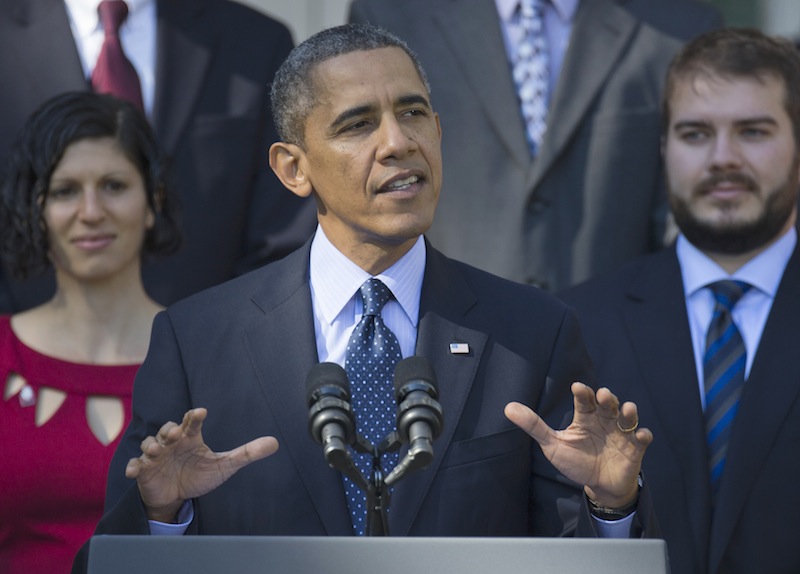The White House strove Monday to explain why Obamacare’s ugly opening act could still be salvaged. They exuded confidence that the technical problems of the last few weeks could be fixed and that the expected pattern for enrollment meant that people would still be able to get enrolled for coverage in time.
But there was one catch. Senior administration officials acknowledged that they’re still taking stock of HealthCare.gov’s underlying problems and analyzing what exactly it’s going to take to fix them. That reality belies the public assurances that the problems will be fixed — and pronto! Simply put, while progress is being made, Obamacare isn’t out of the woods yet.
The White House has insisted that high traffic has been the main source of the website’s problems since Oct. 1, but some problems seem to have persisted even as more servers have been brought online to handle the volume. Reports have also surfaced about insurers having issues on the back end of the website — receiving multiple applications for the same person, among other abnormalities. The senior officials confirmed those reports and said that they had “made improvements” in cooperation with insurers.
They described an effort that is underway, undertaken by a combination of full-time staff and independent contractors, to evaluate the website’s performance and rectify any issues that they find in what the White House is calling a “tech surge.”
Those people have been brought in “to do a top-to-bottom diagnosis that’s reflective of actual day-to-day massive utilization of the website,” one official said. “I think the ability to see and really kick the tires on something is being done now in real terms.”
The volume problem “has generally been resolved, and what the tech surge team is doing right now is that top to bottom, let’s take a look throughout the system. … That diagnosis is intense and ongoing,” one administration official said.
“The system is better today than it was two weeks ago. What the tech surge folks allow us to do is to fix what we know right now isn’t working, but also to identify, to diagnose, if there are other things that need to be addressed and fix them.”
Timing has also become an issue, with many outside observers wondering how long it might take to sort through any problems and fix them. The White House has always said it expects enrollment to pick up starting in mid-November through Dec. 15, the last date that people can enroll in coverage and have it start on Jan. 1, 2014. That gives the administration about four to six weeks to make significant strides in the site’s performance.
“How long do we expect? I think that’s unclear,” the official said. “I can’t say to you right now whether that’s a day or a week. What I do know is that we are throwing everything at it, 24/7.”
“I don’t have a target date,” the official said later. “There’s time. It’ll be fixed.”
But, while some have speculated that the problems could be so deep-rooted that the administration might need to start again from scratch, the officials quickly dismissed that possibility. They also rejected any notion that policy changes to Obamacare — like delaying the individual mandate — are necessary because of the website’s troubled rollout.
“Look, we don’t believe that to be the case,” the official said. “Now we’re taking a look basically to say: What other bugs and glitches are there? Let’s fix them and continue to do that in an iterative way.”
The officials portrayed President Obama’s speech Monday, in which he said that there is “no excuse” for the website’s problems, as a guarantee of sorts that the issues would be resolved and soon.
“The president of the United States went out today in front of a national television audience and expressed his anger and frustration and said this is going to be fixed,” the official said. “That is a clear, clear message to everybody that this is unacceptable.”
So that’s the bad news: Fixing the website is still very much a work in progress. But the administration presented plenty of reasons to be optimistic that it can recover from an undesirable start.
First, they are relying on most people to come to the website at a later date, starting in that mid-November zone. That’s an expectation that they’ve been emphasizing since before the website went live, one based on the health care reform experience in Massachusetts, where most people didn’t sign up for coverage until the last possible moment.
They’re also pointing to the other ways that people can enroll in coverage, like the phone hotline that the president highlighted in his remarks Monday. That diverted volume should presumably help relieve the pressure on HealthCare.gov.
The performance of the federal data hub — the digital meeting place for state, federal and private insurers to review and verify information that people enter into the system — seems to be strong, especially after it was cited as a possible problem point in the months leading up to the website’s launch.
Interest has been robust: Nearly 20 million Americans have visited HealthCare.gov, and close to 500,000 have begun applications on either the federal website or its equivalent at the state level, though official enrollment figures aren’t yet available.
The bottom line, in the administration’s mind, is that the whole enterprise can be redeemed, as long as the problems are remedied in a timely fashion. They routinely point to the experience of Medicare Part D during the second Bush administration, which went through a problematic launch of its own before settling in as the widely supported program it is today.
“The product is good. The health insurance that’s being provided is good. It’s high quality and it’s affordable,” Obama said Monday. “People can save money, significant money, by getting insurance that’s being provided through these marketplaces. And we know that the demand is there.”









